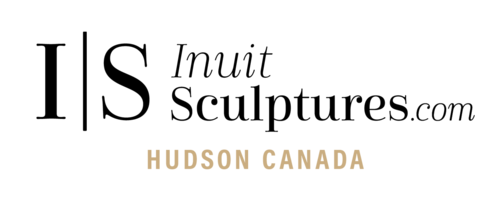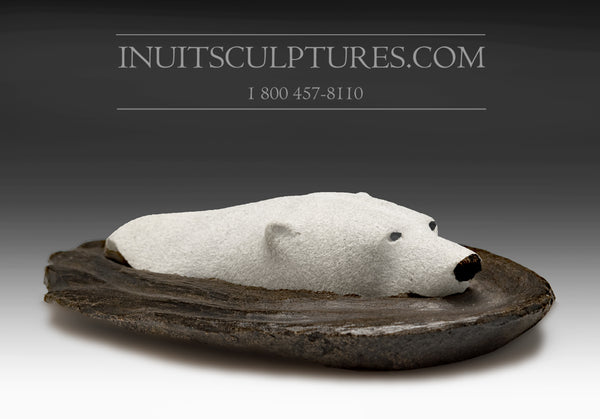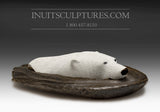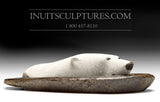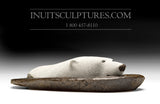7" Swimming Polar Bear by Joseph Suqslaq
View entire collection by:
Joseph Suqslaq
can be reserved, please contact us
Inuit art: Bear
Inuit Artist: Joseph Suqslaq
Size: 6.5" across (6" horizontal), 4" deep, 2" tall
Community: Gjoa Haven, NU
Material: Stone medium Fieldstone
id: c-000
This swimming bear is mischievous and in hiding. Preying for his next kill? Looking for his Seal friends?
The craftsmanship of this bear is absolutely divine. As a curator of the gallery, I am particularly drawn to carvings that are made from mixed media. This one in particular is made from two different stones that contrast splendidly together.
He is hunting, scenting with his nose. He can detect his prey a kilometre away.
Suqsluq is best known for his polar bears. Inuit art enthusiasts around the globe adore his fastidiously detailed work.
Joseph has the rare ability to carve movement into his carvings. Gjoa Haven artists honour the natural spirit of their animal subjects and are unique in their depiction of life.
Joseph’s bear is a MUST for a magical and well rounded collection.
PROUDLY CANADIAN SINCE 2008
Joseph Suqsluq (b. 1958).
Joseph is the son of the late Gjoa Haven carver Joata Suqslak. His mother Lena Qiyuk Suqslak is a carver and crafts artist. Joseph’s brother Moses Pameogarak is also a carver.
“I do mostly soapstone. Some whalebone, not too much. That’s about it, except when I go down south to try other types of stone, like marble. About two years ago, I was awarded a scholarship by the Inuit Art Foundation to go to Vermont, where I did some work with pneumatic tools. I’d never used them before; it was good.
“I’ve been an artist for more than 20 years. When I was 15 or 16 years old, I had a job but noticed that people were making money from carving. I tried it and found that just about anything I carved, I could sell. So I just kept on doing it. Not seriously at first. It was only about eight years ago that I started really carving.
“My grandfather and my uncle carved. My grandfather’s brothers used to carve. I watched and learned. Also, when I was very young—maybe six or seven years old—I found a piece of soapstone out on the land in a tent. I filed it down to a fine finish and when I showed it to my grandfather, he told me I was a very good carver. He paid me for all the hard work I did. I thought it was pretty good, so I just kept on going.
“Our main problem now is getting soapstone. We used to be able to just go to the quarry and pick stone up off the ground. The stone was all on top. For many years now, the loose stone has been gone and we dig out of the ground. You can’t really do that until summertime. We can’t reach it by boat or by anything else in summer. The only time we can reach it at all is in the wintertime, by skidoo and sleds. Our main problem is getting an aeroplane to fly up there and dig it out for the winter. We can’t even get it back to the community when we dig out in the summer because it’s too heavy. We need some money to get a quarry so we can dig stone out in the summer with a few guys. We’d leave them out there for a while to dig it out like they did two years ago. That soapstone lasted for about two seasons but this spring it’s all gone again.
“The Inuit Art Foundation is not only educating people down south about Inuit art, they are also educating southern ways of dealing with Inuit art. They have given us the opportunity to interact with other artists. Some of (those artists’) ideas about art are different from ours, but sometimes we find they have the same ideas.
The above is a excerpt from an interview with Dave Depper, recorded in Ottawa in June 1994. Excerpt courtesy Inuit Art Section, Indian and Northern Affairs Canada (INAC), 1997.
